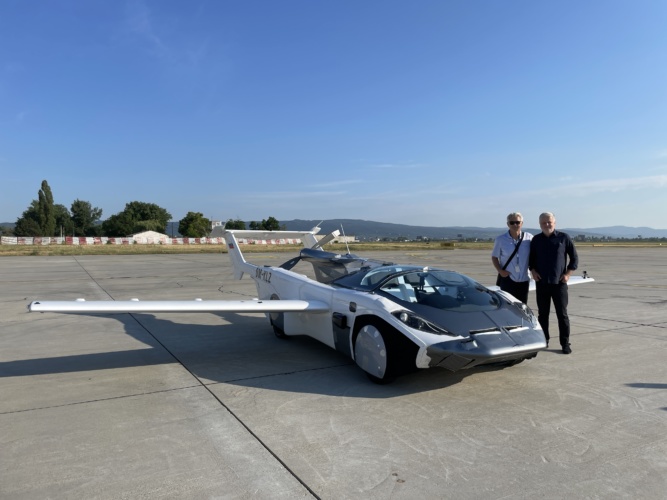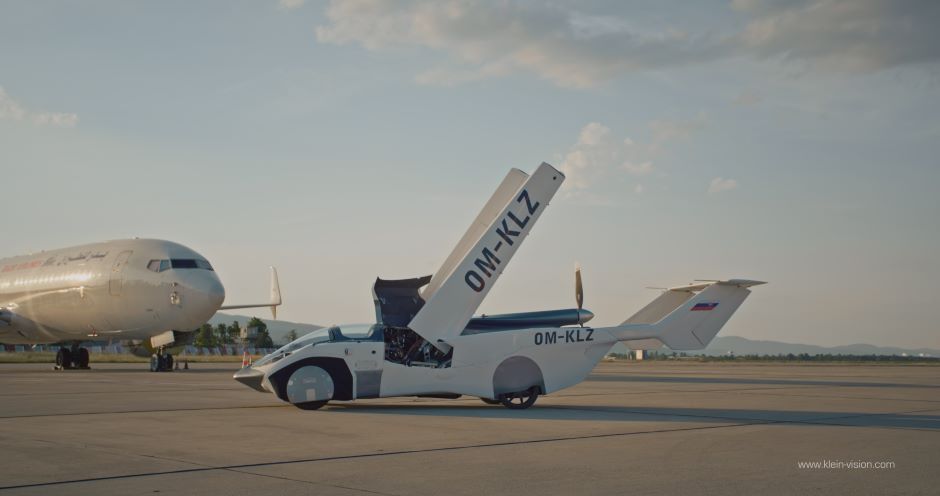
After landing, Klein Vision's AirCar Prototype 1 quickly transitioned into sports car mode for a road journey into downtown Bratislava.
The Engineer spoke to Anton Zajac, co-founder of Klein Vision, to discuss the motivation behind AirCar and the future of dual mode personal transport.
What motivated Klein Vision to develop a flying car?
There are about 20,000 small, private planes in the United States. I’m an owner of one of the planes, and I know what my pain point is: when I… want to fly and go to a hangar, usually I have to take three planes out of the hangar before I can pick out my plane, and then I have to push back the three that I took out. It’s just…too inconvenient. Moreover, to get to the airport, I need to take my car. With an AirCar, you can cut the time and hassles almost infinitely and, if we can sell these to five per cent of the aircraft owners, that’s a huge market right there.
Also, there is a constant babble or discussion right now about what is better: a VTOL or something else? You know, there are 30 million taxis across the planet, and if we could convert 0.01 per cent, we have a huge market.
AirCar navigates course to viable flying cars

According to Morgan Stanley, the market size will grow, and it’ll be at about $850bn in 2030. Morgan Stanley talks about flying car market, and obviously they have in mind also VTOLs and all sorts of flying vehicles. VTOL vehicles are nice, [they have] growing potential; especially when the energy density of the battery cells goes up. But at this point of time, although we have electrically powered planes… the range of such vehicles is very low. And VTOLs are very heavy. Basically, they are some sort of a helicopter, we could say…They don’t use aerofoil lift and, as such, they have very low mileage per unit of energy and that’s why the range is low. Our concept is different, and we believe that infrastructure for flying cars – of our type of AirCar type – is available, is ready.
We have interested investors from China who say, “We have many islands, and we would like to connect these islands” and a flying car is an excellent way to interconnect pieces of land that do not have the infrastructure, the road infrastructure. We can land on grass, and we have a very long range compared to VTOL vehicles. I’m not interested in money but I’m sure there is plenty of ROI in this project.
Will a private pilots license holder require extra training?
The advantage of our AirCar is you don’t need to go to pilot school to learn new techniques [because] it behaves exactly as a small aircraft. The test pilot and inventor, Stefan Klein, who flew AirCar said, “I almost didn’t have to touch anything because the AirCar was flying itself.” So, just a little bit of technology added – you know, GPS and all the pilot technology – was converted into virtually an autonomous vehicle. It’s very stable, and the stability is achieved by very special patented transmission technology.
We convert the car into an aircraft which is very stable by doing two things. First, we pull the wings out and spread the wings. And then we prolong the tail, and this has two advantages. First, it adds the stability to the flying vehicle because the centre of gravity – the distance between the centre of gravity and the control surfaces – is longer. And second, you can actually – after transforming into a car mode – you can park it in your garage.
How does landing gear work on a flying car?
[In] the previous model, which is the 4.5, we had to be taking-off and landing horizontally. This new model, because we changed the geometry, we simulate exactly the taking-off and landing pattern of light aircraft. So, we rotate at take-off, and when we land we touch the rear wheels first. It behaves exactly like a [Piper] or a Cessna or any other small plane.
How much redundancy is in the aircraft?
When it’s transformed in the mode of an aircraft, it must be safe. And so there are several mechanisms – which are patented – that make it a very safe transition from a car into an aircraft. The whole process is monitored by computers, and a record is stored. If there was some problem in that process, the car would not allow a person to take-off. Since we want to certify this as an aircraft, we follow all the protocols that are imposed by civil aviation authorities.
What’s next for Klein Vision?
The next prototype takes…into account the experiences from Prototype One. You know, it is a scientific project, and all the pieces of the technology have been thoroughly calculated. So, on one hand there’s a design component. It looks beautiful. And people...who welcomed us in downtown Bratislava said “This looks like a Ferrari or Lamborghini.” So, it is very slick-looking sports car, the design part is very nice.
But on the other hand, the technology that is built into this model is the result of CFD analyses, and all the key structural elements have been thoroughly calculated. There are hundreds and hundreds of pages of results and charts and…computer-generated images of how the pressure and tension in each part is distributed. We created one prototype which was powered by a 15-hp engine. We attached [sensors] on the surface of this model, and we flew it for many hours. We saw that whatever we calculated was in line with what we measured in this model, so after this we decided to create a real thing, and we built this prototype that is flying. We are very happy with how it behaves; how stable it is. And looking forward to the next stage – which is Prototype Two with a 300-hp engine – we are going to fly from Paris to London.





Poll: Should the UK’s railways be renationalised?
My concern is that if the railways are renationalised, we will be back to the bad old days with no hope of desperately needed modernisation. We are...